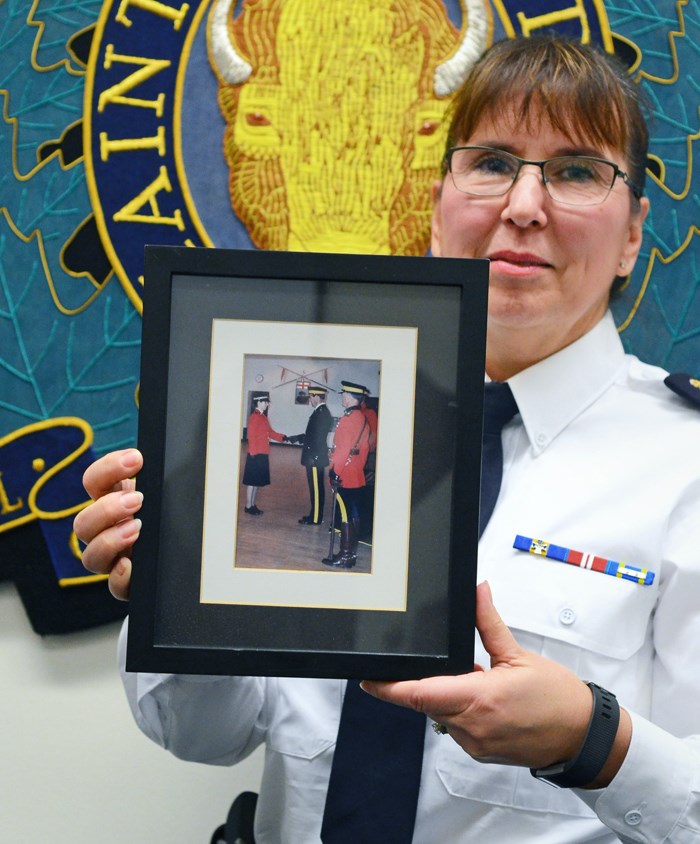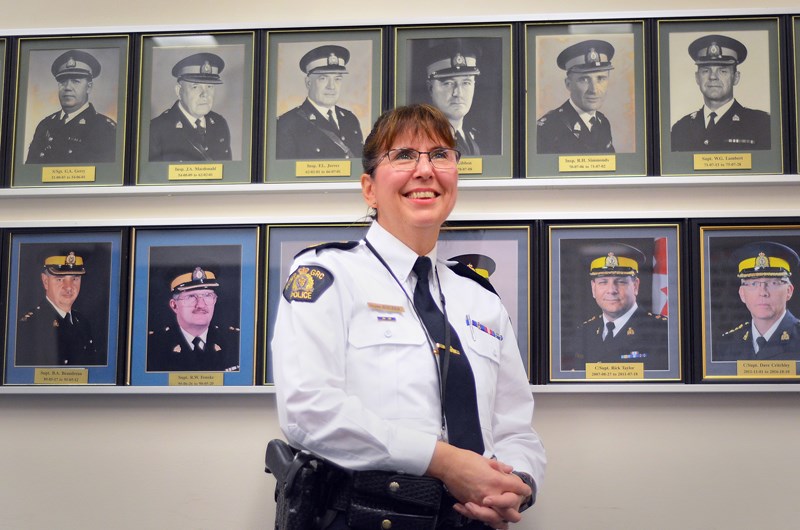Burnaby’s top cop, Deanne Burleigh, won’t talk on the record about two questions she was asked during her first, failed RCMP job interview 38 years ago – suffice it to say, they wouldn’t fly in 2018, the year of #metoo.
“In today’s world? Completely out of line, unacceptable, a violation of human rights, whatever you want to call it,” she says during an International Women’s Day-themed interview at the Burnaby detachment.
The force has progressed “leaps and bounds” since then as far as women are concerned, she says.
Today, Chief Supt. Burleigh heads a detachment where female commissioned officers outnumber their male counterparts four to two, and, looking around at a recent B.C. Association of Chiefs of Police meeting, she says she was happy to see women at every table.
But policing and the RCMP still have work to do, she says.
Burleigh, for example, is the Burnaby RCMP detachment’s first female officer in charge – and women still make up less than 22 per cent of the force.
“I’ve been doing the job 32-and-a-half years,” she says, “and I find it even in this day and age shocking that it’s still ‘first woman, first woman, first woman.’ It’s been that way for many years. When I took over Chilliwack, it’s the first woman; when I took over Burnaby, it’s the first woman, and I’m thinking, ‘How can it possibly be, in 2018, that I’m the first woman?’”
She would like to see the RCMP get to a place where gender is irrelevant.
The phrase “female member” is among her biggest pet peeves.
“I have a tough time talking about being female. For me, it’s about doing the job,” she says.
Beginnings
Burleigh’s mind about becoming a Mountie was made up on May 23, 1974, the day the RCMP announced it was accepting female members.
After school that day, 12-year-old Burleigh found her dad – a longtime member in traffic services, including eight years in Burnaby – unexpectedly at home.
“I’m thinking someone’s died because dad’s on the balcony and he’s never home,” Burleigh says. “He said, ‘I just wanted to let you know the force has announced they’re letting women in.’ I said, ‘Cool, I guess I’ll join.’”
Burleigh, the eldest of three siblings, had been the most intrigued by her dad’s work.
“When he’d bring work home, I was the snoop, trying to see what he was doing and what he was putting together,” she says.
She first applied in 1980 when she was 18.
The offensive interview questions didn’t turn her off the idea, she says. Instead, they convinced her she needed more life experience before applying again.
“I knew that, out in the field, absolutely everything is in front of you,” she says.
She got a job at a Vancouver bank at Davie and Bute, in the centre of what was then called the prostitution capital of Canada.
She even tried her hand at social work for a bit, after attending Langara College and UBC, but decided that wasn’t for her.
“I wanted to help people, but that wasn’t the type of help I wanted to do,” she says.
New recruit
Burleigh got into the RCMP in 1985, when she was 23.
The first female Mounties had graduated from depot 10 years earlier, but the RCMP was still dressing them differently than their male counterparts.
Instead of the distinctive red coat, breeches, high boots and Stetson of the male Mounties’ dress uniform, Burleigh got a skirt, polyester turtleneck, red blazer, heeled pumps and a pillbox cap.
(Her old uniform is now on display at the Richmond RCMP detachment.)

She was still wearing a pillbox cap running foot patrols during the Oka Crisis in Quebec in 1990.
She didn’t get her first proper forage cap until a male colleague agreed to order an extra one and give it to her.
And she wasn’t fitted for her first red serge coat, breeches and boots until 1992 – when she was five months pregnant.
“Needless to say it fit very loosely for a very long time,” she said.
(Burleigh has four daughters; two of her own and two stepdaughters – none of whom followed her into policing.)
But the uniform isn’t all that’s changed for women in the RCMP since she first joined.
During 10 years of federal policing in Montreal in the 1980s, for example, Burleigh – despite carrying a gun and a badge – still had to talk her way into men-only bars during investigations.
At Oka, she and another female member were the first to be relegated to kitchen duty.
“That was the reality of the day, and you just kind of had to find ways to work around it and say in whatever voice you had, ‘This isn’t right. We have to change this,’ and, in the interim, do your job and show that you had the ability to do your job and move forward,” she said.
Setting the tone
Much of Burleigh’s strong personality has been built up over years of doing just that, she says.
“When I was a young, new, green member, I wasn’t as strong, nor were there as many people around me that were supportive and mentors and people I could go to,” she says.
When it came to sexual harassment, though, she says she set the tone in her first or second year, after a senior officer acted “inappropriately” at an after-hours RCMP party.
“It wasn’t welcome, and, after a beverage or two, I told him so, straight up and with some colourful language,” Burleigh says.
She was hauled into his office the next morning to be written up for talking to a senior officer that way. She told him to go ahead and that she’d take the opportunity to record why she’d done it.
In 2016, as part of a settlement in two class-action lawsuits, the RCMP formally apologized to female members for gender-based discrimination and sexual harassment dating back to the 1970s, and committed to a range of anti-harassment training and enforcement.
A lawyer in the case has said she wouldn’t be surprised if as many as 3,000 or 4,000 women filed claims before the court deadline.
As a senior female officer, Burleigh says her approach to the suit has been to empower other female members to make their own decisions about filing a claim.
“If they need to talk it through first to get there, absolutely, or afterwards,” she says.
A different lens
Does it make a difference having a female officer in charge?
“I think it makes a difference having an officer in charge who’s willing to stand up and do the right thing, female or male, but I think for some women it’s easier to talk to a female officer,” she says.
Women and men bring a different lens, not only to leadership, but to policing generally, according to Burleigh.
“We all have to be able to shoot a gun; we have to be able to physically defend ourselves; we have to know our powers of arrest; there has to be a certain intellect and understanding of the law. The skill sets there are pretty basic,” she says. “The difference is the way we approach it. You know, I’m not going to walk into a bar fight, pick the biggest guy and push him against the wall and say, ‘OK, fight’s over.’ It’s not going to work for me. It’s the way we go in, the way we approach it.”
Female police officers are more apt to engage “clients” in a conversation to get things done, according to Burleigh.
In leadership, she says, women are more relationship motivated and are more likely to share information and seek input from others.
For the four decades or so that women have been in the force, Burleigh says there has been “a lot of cross pollination” between these different approaches, and that’s good for the force – but more is needed.
“Would I support and encourage women to move up in the organization? Absolutely,” she says. “They bring a different lens, and not just the women but visible minorities, diversity, bring it forward. It brings a different lens, and every lens makes a huge difference on how we offer the service to the community, because we should be reflecting the community. Women are only 20 per cent in the organization. My best guess is there’s more than 20 per cent women in the population.”
To attract more women, Burleigh says the force is going to have to keep working on taking down barriers to employment and advancement, including creating more flexible work hours for those caring for children or aging parents.
After more than 40 years of women in the RCMP, however, one thing new female recruits have today that Burleigh and others who joined early didn’t have is female leaders and role models, and that should help.
“I’m willing to share everything that I do know,” Burleigh says. “What I’ve learned and what I am today is of no value unless I share it.”



